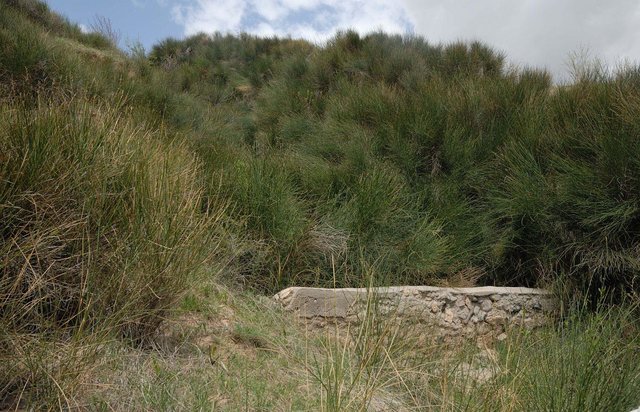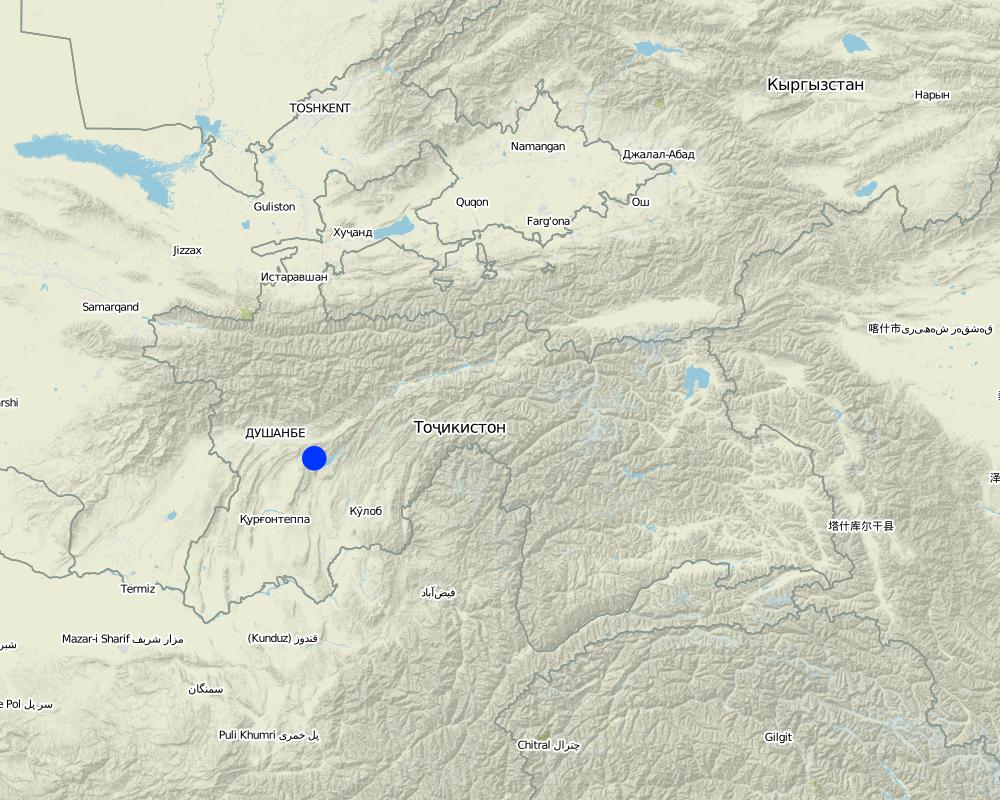Field research station for analysing soil conservation measures [طاجيكستان]
- تاريخ الإنشاء:
- تحديث:
- جامع المعلومات: Gulniso Nekushoeva
- المحرر: –
- المُراجع: David Streiff
approaches_2573 - طاجيكستان
عرض الأقسام
توسيع الكل طي الكل1. معلومات عامة
1.2 تفاصيل الاتصال بالأشخاص الرئيسيين لمصدر المعلومات والمؤسسات المعنية بتقييم وتوثيق النهج
متخصص في الإدارة المستدامة للأراضي:
متخصص في الإدارة المستدامة للأراضي:
اسم المؤسسة (المؤسسات) التي سهلت توثيق/تقييم النهج (إذا كان ذلك على صلة)
Tajik Soil Insitute (Tajik Soil Institute) - طاجيكستاناسم المؤسسة (المؤسسات) التي سهلت توثيق/تقييم النهج (إذا كان ذلك على صلة)
CDE Centre for Development and Environment (CDE Centre for Development and Environment) - سويسرا1.3 الشروط المتعلقة باستخدام البيانات الموثقة من خلال WOCAT
يوافق جامع المعلومات والشخص (لاشخاص) الرئيسي لمصدر المعلومات على الشروط المتعلقة باستخدام البيانات الموثقة من خلال WOCAT:
نعم
1.4 المراجع الخاصة باستبيان(استبيانات) تقنيات الإدارة المستدامة للأراضي

Gully rehabilitation [طاجيكستان]
Gullies are stabilized through the establishment of a gabion and the plantation of spanish drok (Spartium junceum L).
- جامع المعلومات: Qobiljon Shokirov
2. وصف نهج الإدارة المستدامة للأراضي
2.1 وصف موجز للنهج
Research Station of the Tajik Academy of Agrarian Science, Soil Institute conducting research on soil conservation and productivity in the rainfed hill zones of central Tajikistan.
2.2 وصف تفصيلي للنهج
وصف تفصيلي للنهج:
Aims / objectives: The main goal of the research station is the rehabilitation and protection of erosion prone loess areas through monitoring of soil erosion and soil moisture, gully rehabilitation, rehabilitation of degraded pastures through the establishment of a vineyard on terraced land.
Methods: Researchers and students of the department of soil erosion together with the field station manager and several laboratory assistants are conducting field experiments for their research e.g. standardised runoff plots. The demonstration plots are also used in teaching of university students and for project visits.
Stages of implementation: The research station was established in 1968.
Role of stakeholders: The land belonging to the field station was rented out to a group of 5 farmers who are directed by the researchers and have to deliver 50% of the crop yield to the soil institute.
Other important information: During the last years the research station has received additional support from international organisations and programmes such as ICARDA, IAEA-FAO and NCCR North-South for renovating infrastructure (buildings, climate station etc.).
2.5 البلد/المنطقة/المواقع التي تم تطبيق النهج فيها
البلد:
طاجيكستان
المنطقة/الولاية/المحافظة:
RRS
مزيد من التفاصيل حول الموقع:
Faizabad, Javonon, Karsang
Map
×2.6 تواريخ بدء وإنهاء تنفيذ النهج
أشر إلى سنة البدء:
1968
2.7 نوع النهج
- research
2.8 الغايات/الأهداف الرئيسية للنهج
The Approach focused mainly on SLM with other activities (productivity increase, testing of crop types)
The main goal of the research station is the rehabilitation and protection of erosion prone loess areas through monitoring of soil erosion and soil moisture, gully rehabilitation, rehabilitation of degraded pastures through the establishment of a vineyard on terraced land.
The SLM Approach addressed the following problems: knowledge gaps in agricultural production and soil erosion
2.9 الظروف التي تمكن أو تعيق تنفيذ التقنية/التقنيات المطبقة بموجب النهج
توفر/الوصول إلى الموارد والخدمات المالية
- معيق
lack of finances to conduct research
Treatment through the SLM Approach: mobilization of government funding
الإطار المؤسساتي
- معيق
technical experts were not available
Treatment through the SLM Approach: capacity building of institutional human potential
الإطار القانوني (حيازة الأراضي، وحقوق استخدام الأراضي والمياه)
- تمكين/تمكيني
The existing land ownership, land use rights / water rights greatly helped the approach implementation: state ownership of land facilitated the establishment of the research station
- معيق
legal status unclear
Treatment through the SLM Approach: new law that the land of the research station can not be given away as certificate
المعرفة حول الإدارة المستدامة للأراضي، والوصول إلى الدعم الفني
- معيق
lack of technical equipment
Treatment through the SLM Approach: provided by government and rented by land users
غير ذلك
- معيق
limited agricultural knowledge
Treatment through the SLM Approach: pilot projects, disseminate knowledge through trainings and seminars
3. المشاركة وأدوار الأطراف المعنية
3.1 أصحاب المصلحة المعنيون بالنهج وأدوارهم
- مستخدمو الأراضي المحليون/المجتمعات المحلية
- متخصصون في الإدارة المستدامة للأراضي / مستشارون زراعيون
- الحكومة المحلية
- الحكومة الوطنية (المخططون، صانعو القرار)
- Academy of Aicultural Sciences
3.2 انخراط مستخدمي الأراضي المحليين/المجتمعات المحلية في المراحل المختلفة للنهج
| انخراط مستخدمي الأراضي المحليين/المجتمعات المحلية | حدد من شارك وصف الأنشطة | |
|---|---|---|
| المبادرة/التحفيز | غير موجود | |
| التخطيط | غير موجود | |
| التنفيذ | الدعم الخارجي | |
| الرصد/التقييم | تفاعلي | |
| Research | غير موجود |
3.4 اتخاذ القرار بشأن اختيار تقنية/تقنيات الإدارة المستدامة للأراضي
حدد من الذي قرر اختيار التقنية/التقنيات التي سيتم تنفيذها:
- متخصصون في الإدارة المستدامة للأراضي بشكل أساسي، بعد التشاور مع مستخدمي الأراضي
اشرح:
During Soviet times it was a a top-down government approach to adress knowledge gaps through research. In recent times the farmers have repeatedly taken initiative to tackle problems by writing letters to the institute. IN the end it is the institute that takes the final decisions.
Decisions on the method of implementing the SLM Technology were made by mainly by SLM specialists with consultation of land users
4. الدعم الفني وبناء القدرات وإدارة المعرفة
4.1 بناء القدرات/التدريب
هل تم تقديم التدريب لمستخدمي الأراضي / الأطراف المعنيين الآخرين؟:
نعم
حدد من تم تدريبه:
- مستخدمو الأراضي
- university students
إذا كان ذلك على صلة، حدد الجنس والعمر والوضع والعرق وما إلى ذلك.
land users who are employed at the research station
شكل التدريب:
- في العمل
- مناطق العرض
- دورات
المواضيع المغطاة:
soil erosion, agricultural productivity
4.2 خدمة استشارية
هل يملك مستخدمو الأراضي وصولا إلى خدمة استشارية؟:
نعم
وصف/تعليقات:
Advisory service is inadequate to ensure the continuation of land conservation activities; lack of finances to conduct new research
4.3 تعزيز المؤسسات (التطوير التنظيمي)
هل تم إنشاء أو تعزيز مؤسسات من خلال هذا النهج؟:
- لا
4.4 الرصد والتقييم
هل يشكل الرصد والتقييم جزءا من النهج؟:
نعم
التعليقات:
bio-physical aspects were regular monitored by government through measurements; indicators: soil moisture, soil loss, runoff, soil fertility properties, climate indicators
technical aspects were regular monitored by government through measurements; indicators: different crop rotations
economic / production aspects were regular monitored by government through measurements; indicators: yields
There were several changes in the Technology as a result of monitoring and evaluation: different crop rotation schemes, mulching of vineyards, adaptation of fertilizer amount applied
4.5 البحوث
هل كانت البحوث جزءًا من النهج؟:
نعم
حدد المواضيع:
- تكنولوجيا
أعط تفاصيل إضافية وأشر إلى من قام بالبحوث:
researchers from the soil institute conducting research on soil erosion and agricultural productivity, university students conducting mainly Phd and Postdoc research
Research was carried out on station
5. التمويل والدعم المادي الخارجي
5.1 الميزانية السنوية لمكون الإدارة المستدامة للأراضي في النهج المذكور
التعليقات (على سبيل المثال المصادر الرئيسية للتمويل/الجهات المانحة الرئيسية):
Approach costs were met by the following donors: government: 100.0%
5.2 الدعم المالي/المادي المقدم لمستخدمي الأراضي
هل حصل مستخدمو الأراضي على دعم مالي/ مادي لتنفيذ التقنية/ التقنيات؟:
نعم
إذا كانت الإجابة بنعم، حدد نوع (أنواع) الدعم والشروط والمزودين:
Fully financed by the government through the Academy of Science
5.3 إعانات لمدخلات محددة (بما في ذلك العمالة)
- معدات
| حدد المدخلات التي تم دعمها | إلى أي مدى | حدد الإعانات |
|---|---|---|
| أدوات | ممول بالكامل | |
| climate station | ممول بالكامل | |
- زراعة
| حدد المدخلات التي تم دعمها | إلى أي مدى | حدد الإعانات |
|---|---|---|
| بذور | ممول بالكامل | |
| أسمدة | ممول بالكامل | |
| seedlings | ||
- بناء
| حدد المدخلات التي تم دعمها | إلى أي مدى | حدد الإعانات |
|---|---|---|
| حجر | ممول بالكامل | |
| خشب | ممول بالكامل | |
- بنى تحتية
| حدد المدخلات التي تم دعمها | إلى أي مدى | حدد الإعانات |
|---|---|---|
| طرق | ممول بالكامل | |
| soil laboratory | ممول بالكامل | |
إذا كان العمل من قبل مستخدمي الأراضي مدخلاً جوهريًا، فهل كان:
- مقابل دعم مادي آخر
التعليقات:
Labour is paid in cash as well
50% of the yield belongs to the land users
5.4 الائتمان
هل تم توفير ائتمان في إطار نهج أنشطة الإدارة المستدامة للأراضي؟:
كلا
5.5 حوافز أو وسائل أخرى
هل تم استخدام حوافز أو أدوات أخرى لتشجيع تنفيذ تقنيات الإدارة المستدامة للأراضي؟:
كلا
6. تحليل الأثر والتصريحات الختامية
6.1 آثار النهج
هل ساعد النهج مستخدمي الأراضي على تنفيذ وصيانة تقنيات الإدارة المستدامة للأراضي؟:
- لا
- نعم، قليلا
- نعم، باعتدال
- نعم، إلى حد كبير
During Soviet times recommendations for the land committee were elaborated based on results from the research station, nowadays these mechanisms are not in place anymore and knowledge dissemination to land users is hardly taking place.
هل ساهم النهج في تمكين الفئات المحرومة اجتماعيا واقتصاديا؟:
- لا
- نعم، قليلا
- نعم، باعتدال
- نعم، إلى حد كبير
هل أدى النهج إلى تحسن في مسائل حيازة الأراضي / حقوق المستخدمين التي أعاقت تنفيذ تقنيات الإدارة المستدامة للأراضي؟:
- لا
- نعم، قليلا
- نعم، باعتدال
- نعم، إلى حد كبير
before, land was under common use and therefore no conservation activities were implemented
Did the Approach help to alleviate poverty?
- لا
- نعم، قليلا
- نعم، باعتدال
- نعم، إلى حد كبير
6.2 المحفز الرئيسي لقيام مستخدمي الأراضي بتنفيذ الإدارة المستدامة للأراضي
- المدفوعات/ الإعانات
- القواعد واللوائح (الغرامات) / الإنفاذ
top-down enforcement
- الوجاهة والضغط الاجتماعي/التماسك الاجتماعي
6.3 استدامة أنشطة النهج
هل يمكن لمستخدمي الأراضي المحافظة على استدامة ما تم تنفيذه من خلال النهج (بدون دعم خارجي)؟:
- نعم
إذا كانت الإجابة بنعم، صف كيف:
farmers continue with maintenance activities
6.4 نقاط قوة/مزايا النهج
| نقاط القوة/ المزايا/ الفرص من وجهة نظر مستخدمي الأراضي |
|---|
| Access to new technologies for farmers working on the research station (How to sustain/ enhance this strength: ensure ongoing research activities) |
| Capacity building for PhD and Postdoc students |
| نقاط القوة/ المزايا/ الفرص من وجهة نظر جامع المعلومات أو غيره من الاشخاص الرئيسيين لمصدر المعلومات |
|---|
| Specific knowledge gaps can be adressed with field experiments (How to sustain/ enhance this strength: ensure ongoing financial support for research activities from diverse sources such as government, international organisations or through provision of services) |
| Enables longterm research and monitoring (How to sustain/ enhance this strength: continued government ownership and support) |
6.5 نقاط الضعف/ العيوب في المنهج وطرق التغلب عليها
| نقاط الضعف/ المساوىء/ المخاطر من وجهة نظر جامع المعلومات أو غيره من الاشخاص الرئيسيين لمصدر المعلومات | كيف يمكن التغلب عليها؟ |
|---|---|
| On-station approach might not reflect the situation of local farmers | using the research station as a base for conducting research on land of surrounding villages |
| Nowadays there are no efforts to disseminate the knowledge among local farmers in Tajikistan | establishment of advisory services, training courses, farmer schools |
| Since the early 90ies the involvement of university students has strongly decreased due to lack of financial resources | facilitating fieldwork and internships through the Soil Institute and the Tajik Agrarian University |
7. المراجع والروابط
7.1 طرق جمع/مصادر المعلومات
- زيارات ميدانية، مسوحات ميدانية
- مقابلات مع مستخدمي الأراضي
الروابط والوحدات المواضيعية
توسيع الكل طي الكلالروابط

Gully rehabilitation [طاجيكستان]
Gullies are stabilized through the establishment of a gabion and the plantation of spanish drok (Spartium junceum L).
- جامع المعلومات: Qobiljon Shokirov
الوحدات المواضيعية
لا يوجد وحدات مواضيعية


